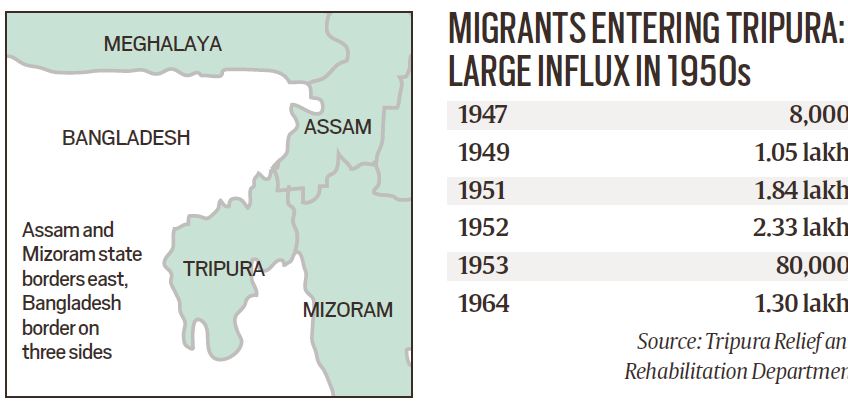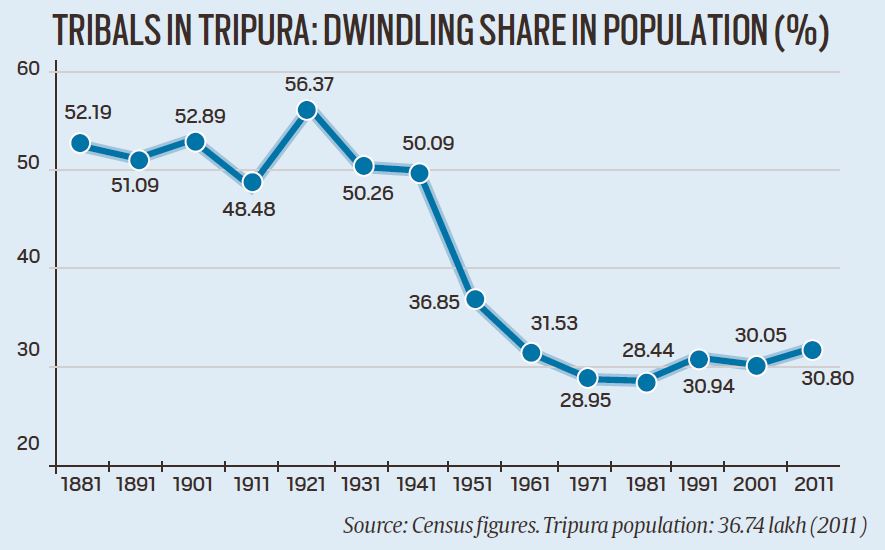Context:
- Kirit Pradyot Debbarman Manikya, son of the last King of Tripura, plans to move the Supreme Court demanding a National Register of Citizens on the lines of the NRC in Assam.
- Days earlier, the Supreme Court had issued a notice to the Centre on a similar plea from a forum called the Tripura People’s Front.
- A look at the history of migration and its effect on the state’s politics, leading to the NRC demand:
Who are Tripura’s indigenous people?
- There are 19 notified Scheduled Tribes in Tripura, among whom the Tripuris are the largest group. The Tripuris are also considered the aboriginals as they migrated first.
- The princely state of Tripura was ruled by the Manikya dynasty, belonging to the Tripuri community, from the late 13th century until the signing of Instrument of Accession with the Indian government on October 15, 1949.
- Other groups migrated at various times — Reang and Jamatia (via the Chittagong Hill Tracts from parts of Burma), Bhil, Orang and Santal (from parts of central India and Bengal), besides Noatia, Uchoi, Kuki, Halam, Lushai, Bhutia, Lepcha, Khashia, Chakma, Mog, Garo, Munda, and Chaimal.
- The 2011 Census puts the number of Tripuris, who belong to the Indo-Mongoloid family, at 5.92 lakh, followed by Reangs (1.88 lakh) and Jamatias (83,000).

What is the extent of migration by non-tribal groups?
- In the 1881 Census, tribals constituted 63.77% of Tripura’s population; in 2011, this was down to 31.80%. This followed the migration of 6.10 lakh Bengalis between 1947 and 1971, displaced from then East Pakistan.
- The enormity of the influx shows when one compares these 6.10 lakh to the entire state’s 1951 population, which was 6.39 lakh.
- According to Subir Bhaumik, an author-journalist from the region, while migration was high after Partition, it wasn’t entirely absent before 1947.
- The Manikya kings had hired Bengalis from their estate in Chakla Roshanabad (now in Bangladesh) to work in its administration, and encouraged them to settle in the plains to spread settled cultivation.

How many Bengalis live in Tripura now?
- According to Language Census 2011, Bengali was the mother tongue of 24.14 lakh people in Tripura. This represents 2/3rds of the 36.74 lakh population, and almost three times the 8.87 lakh who speak Kokborok — a language of the Tibeto-Burman family and the mother tongue of the largest tribal groups. In 1979, Kokborok was accorded the status of official language, alongside Bengali and English.
- It uses the Bengali script; indigenous groups have been demanding recognition of the Roman script for Kokborok.
- The dominance of Bengali, however, cannot be attributed to recent migration alone. It was the official court language of princely Tripura at a time when English was the official language of Bengal. Manikya kings promoted Bengali.
- Rabindranath Tagore visited Tripura seven times, and was accorded the title of “Bharat Bhaskar” by the royal house, which also donated during the construction of Visva Bharati University. “Why should we have any problem with families that have contributed a lot to our state?” said Pradyot, before moving the Supreme Court for an NRC. Pradyot, also the working president of the Tripura Congress, said the issue is of illegal migration after Tripura’s merger with the Indian Union.
Has migration not been an issue earlier?
- Bhaumik, who has authored Troubled Periphery: The Crisis of India’s North East, said the first tribal insurgent group to emerge was the Sengkrak (Clenched Fist) in the 1960s.
- On June 5, 1980, insurgents massacred nearly 350 Bengalis in west Tripura, followed by another 1,000 killings over the next few days. In 1988, the militant group Tripura National Volunteers (TNV), entered into a peace agreement with New Delhi, but rebels formed a splinter group, National Liberation Front of Tripura (NLFT) in 1992.
- The All Tripura Tribal Force (ATTF) was formed in 1990, later renamed All Tripura Tiger Force.
- According to the South Asia Terrorism Portal, 2509 civilians, 455 security personnel and 519 insurgents were killed between 1992 and 2012. ‘Understanding Tipraland movement through migration in Tripura’, a paper by scholars Mrinal Kanti Deb and Aurobindo Mahato, identifies “land alienation” as the root cause behind ethnic strife. Pradyot says Tripura requires land reforms and also a revisit of political representation.
How are tribals politically represented?
- The Tripura Tribal Autonomous District Council, covering 2/3rds (7,332 sq km) of the state’s area, was set up in 1979 and brought under the Sixth Schedule in 1985.
Source:IE
